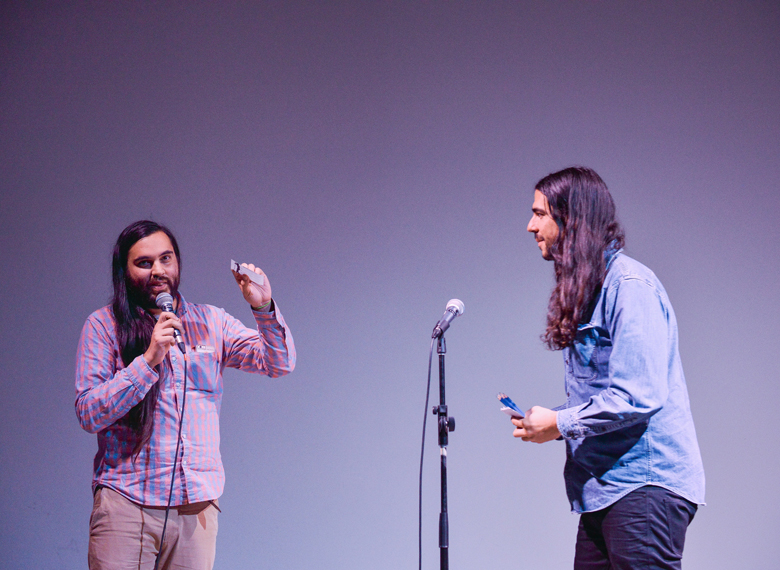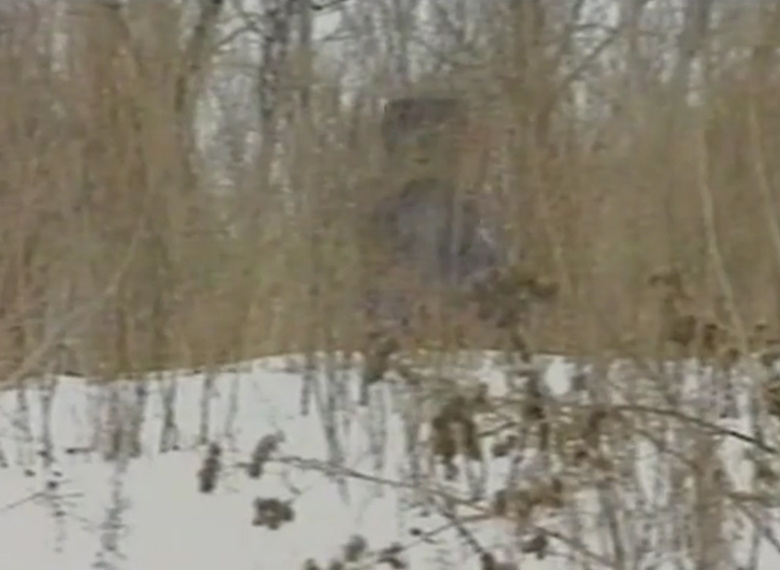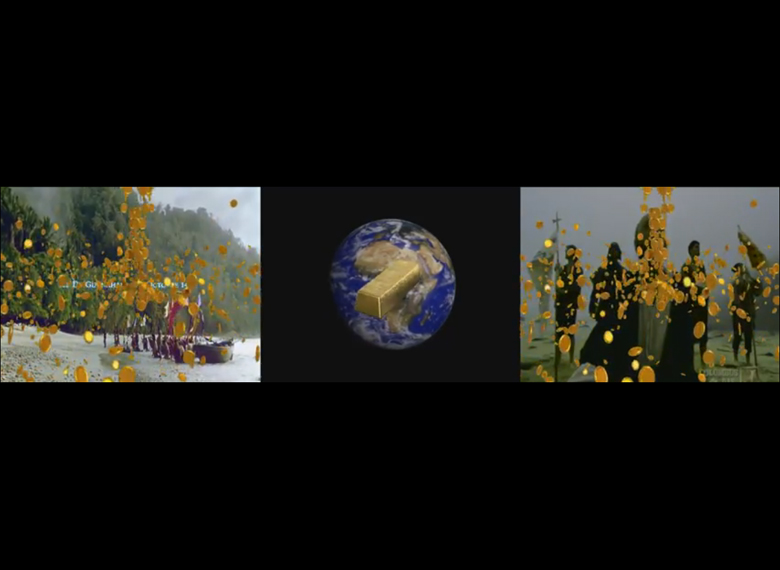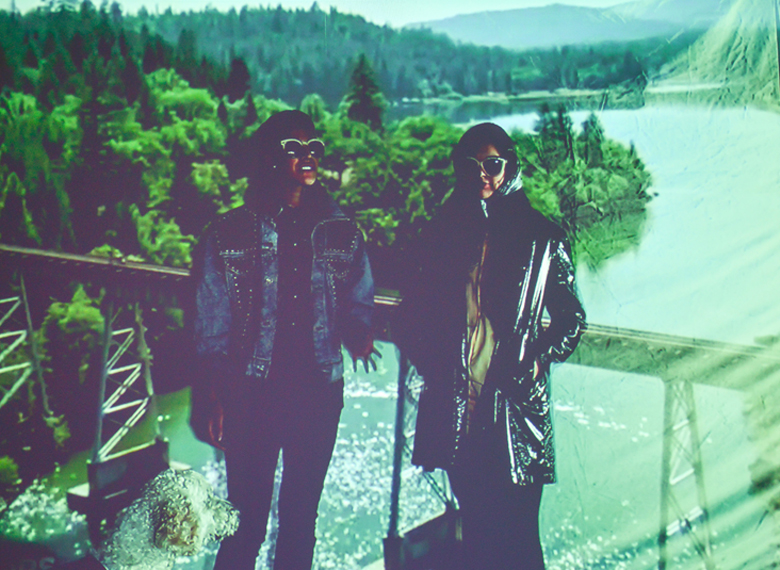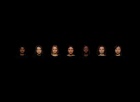thirstDays is a project conceived as the rain falls and covers us in slick substance transduced from the skies, moist. How can this, how can we, contribute to the establishing of a momentum that may have once been here in waves or pieces but over time was squandered, and defeated, with the imposition of capital triumphantly declaring its colonial (un)consciousness in our enclave by the water. Surrounded by a possible serene beauty, grief and sadness, love and hate, what encounters do we inscribe into our psyches and into our beings, what can art do to fulfil a mandate of hope and agency. What can we contribute.1
I connect to the stream. The image presents itself on the screen of my laptop, a shaky, hand-adjusted frame that quickly steadies, focusing on the stage at VIVO Media Arts in Vancouver, BC. This is the eighth iteration of VIVO’s thirstDays—an on-going series of thirteen events organized by curator/artist-in-resident Jayce Salloum. I am streaming it on September 29th, three hours ahead, on Attawandaron territory, in my dimly lit apartment.
thirstDays No. 8: SO WIDE SO LOW SO HIGH, guest-curated by Haida artist Raymond Boisjoly and Musqueam First Nation artist Jordan Wilson, is set to include works by Darryl Nepinak, Zack Khalil and Raven Chacon, Krista Belle Stewart, Sigbjørn Skåden, and Chandra Melting Tallow and Elle-Máijá Tailfeathers. For this edition of thirstDays, unlike the previous seven, there is technically no “predetermined curatorial thesis.” Instead, the curators decided to let “shared concerns. . . emerge in negative spaces between the works themselves.”2
I feel disembodied. I am absent, yet physically aware. Each film work is displayed as a tilted, fully dimensional rectangle, hedged at the bottom by the dark silhouettes of audience members’ heads. I, ultimate voyeur, am present, watching, analyzing. No one is aware (nor could they be) of my head casting a shadow onto my laptop screen. A multiversal sensibility is given to the curatorial question Boisjoly and Wilson ask: “What do we do when the obstacles we face are not of convenient dimensions?”3
I am struggling to find my presence within the indefinite realms of the virtual stream. I think there is a one-second delay on all the sound until, to my chagrin, I discover I have had two windows of the same stream open all along. So I began, disembodied yet present, setting out to connect through a flawed lens.
The event opens with curator Jayce Salloum singing Patsy Cline’s classic heartbreaking tune, “Crazy for Loving You” to the excited crowd, his rendition the first of many karaoke breaks scheduled to take place between works throughout the night. Presented solely by past and future curators of thirstDays, the chart-topper pop karaoke segments serve to break down hierarchical structures within the roles of the project, demystify the concept of the ‘curator,’ and bringing a unique sense of intimacy and connectedness. Opening the event with such vulnerability, the curators build the very foundation upon which SO WIDE SO LOW SO HIGH will operate.
The first piece to be introduced is the short film, The Last of the Nepinaks (2005) by Skownan First Nation artist Darryl Nepinak. The film follows a toddler moving against the bright white, winter-set prairie landscape of an indistinct place just outside of Winnipeg, MB. The playful use of classic film tropes throughout the piece—the epic hero struggling through nature to find his way—sets a humourous tone for both the film as well as for the works to come. Drawing attention to colonial assumptions about Indigenous identity within the landscape, and the perpetuation of these assumptions in blockbuster film, the work highlights the topic of landscape threaded through the program yet to come.
Documentation of Navajo First Nation artist Raven Chacon’s composition, Report, lights up—music written for firearms. The wall becomes a vast open landscape, an outdoor shooting range. Acting as gun musicians, complete with music stands and sheet music, a unified line of Indigenous riflemen and women fire their instruments into the landscape, creating a dissonant melody, notes that resonate beyond their instruments’ original intention. The slanted angle of the projection in my view gives the video a newfound constitution, a sort of autonomy from the flat, two-dimensional form. The rectangle is no longer merely on the wall. The images are sculptural, visceral, dreamlike. Despite the much smaller format I am actually experiencing, it feels as though my vantage point is bigger, more substantial, and super-reality thankfully soon interrupted and grounded by a segment of karaoke.
Tom Petty’s “Don’t Do Me Like That,” sung by curators Boisjoly and Wilson punctuates the period after Chacon’s film, a break not only separating the pieces from the next in time, but also managing to create distinction between and relief from their burgeoning presences. With the conclusion of the song, Sámi poet and writer Sigbjørn Skåden’s voice comes through my speakers, beginning to tell stories of experiences in his homeland, the region of Sápmi, which stretches over northern Fennoscandia. Reading from his work, Våke over dem som sover (Watch Over Those Who Sleep) and Notáhtat Márkosámi čoahkasis (Notes from a Backwoods Sámi Core), Skåden vividly describes the natural elements of the land. I feel as if I could embody the elements he speaks of: heather, frosty white earth, the dense forest, flat plains, oppressive darkness…the waterfall, the rainwater, being enveloped in water…and I am brought again to think of thirstDays’ curatorial statement: “. . .a project conceived as the rain falls and covers us in slick substance transduced from the skies, moist.”4 Water is able to manifest itself in many different forms, digitally, visually, and—in this particular case—as spoken text. I can’t see him, he is escaping my purview; all I know is his voice.
Toronto-based artist Stacy Ho and Iranian-born editor and writer Anahita Jamali Rad sing "Don’t You Want Me" by electropop 80’s band The Human League. An intermission follows. We are encouraged to view Krista Belle Stewart’s installation piece, Where the Sea Boils, an 8-channel video installation work set up in an adjoining room called the micro-cinema. Unfortunately out of my view due to the limited perspective of the camera, Stewart’s installation was active throughout the night and mentioned intermittently by the curators. I watch an abstract animation of shadows on-screen, narrated by the mumbling of the gathered crowd.
The intermission ends. The short video The Sin of Omission (2013) by Ojibwe filmmaker and artist Zack Khalil lights the screen, split into three equal sections. The middle encases a spinning globe, while the two outer sides show re-enactments of Christopher Columbus landing on North American shores. Khalil’s layering of early-internet graphic aesthetics over appropriated film—gold coins rain down over the side panels, a gold brick rotates overtop the central globe—makes the crowd burst into laughter, a mood that quickly disintegrates as the visuals and audio transition. The sound of a children’s nursery song comes on. It describes Columbus’s journey to the new world, evident on the side screens. The centre panel displays graphic images of Indigenous bodies, Indigenous people being violently massacred. The film ends with the solitary rotating globe again, solely occupying the screen, leaving the room in silence. My apartment is also silent.
Karaoke transition. It’s Elton John’s Benny and the Jets, sung by Brit Bachmann. The final contributors are introduced—I’ve been watching for about an hour and a half. First-time collaborators Chandra Melting Tallow of the Siksika Nation, and Elle-Máijá Tailfeathers of Blackfoot and Sámi ancestry, enter my laptop screen to the tune of “Use Somebody” by Kings of Leon. Playfully introducing themselves as the “headliners” of the show and parodying the privileged ‘Artist,’ the pair ask audience members to join them on stage to read out dictionary definitions for the words from the thirstDays theme: love, compassion, intimacy, and geopolitics. In collectively defining these words, Melting Tallow and Tailfeathers set up the context for their succeeding “multimedia presentation”—the collaborative video and extension of their live introduction, VERSAEARCOLONION (2016).
A 15-minute video in which the pair continues as their alter-ego selves, VERSAEARCOLONION splices together footage of Melting Tallow and Tailfeathers with celebrities, asking them for their thoughts on love. Speaking with a stereotypically exaggerated uptalk, they interview the likes of Truman Capote, Corey Haim, Eartha Kitt, Joni Mitchell, Whoopi Goldberg and bell hooks. Concluding the interviews is a clip of bell hooks:
We’ve always thought of our heroes as having to do with death and war. And, you know, we think of Joseph Campbell and the whole idea of the heroic journey. It’s rarely a journey that’s about love. It’s about deeds that have to do with conquering, domination, what-have-you, and so, part of what I wanted to say to people is that, living as we do in a culture of domination—to truly choose to love is heroic.
The alter-egos of Melting Tallow and Tailfeathers, awkwardly stunned by the sincerity and depth of this response, offer bell hooks VIP celebrity in exchange for her presence at their upcoming show.
After the interview segment, the two share their response to their interview-survey: “Unfortunately, due to the effects of intergenerational trauma, as a result of ongoing colonization of Indigenous people, love may seem more difficult to attain than ever…I’ll spell intergenerational trauma out for you, if you want to write it down or look it up…” offering Google as a great resource, and www.trudea.understands.com.
Having covered love and intimacy, they move onto compassion, nearly getting hit by the “Settler Shame Train,” and moving into the segment titled “White Settler Girl Who Feels Really Bad,” mentioning the recreational settler appropriation of ayahuasca and sweat lodges. Melting Tallow, playing the character of the White Settler Girl, asks the question: “What can I do to be a better ally or a better white person?”—the answer, she says, is: “Going to more art openings, film screenings, lectures, and poetry readings featuring Indigenous people. Better yet, make yourself an Indigenous friend, and then go and tell all your white friends about them.”
From there, they move onto geopolitics, a “performance piece” called AnaCONDO VS Hagatha Crispy, featuring two members of the “League of Lady Wrestlers.” AnaCONDO wins in the end after a difficult fight, bending Crispy almost in half. The overpriced real estate market of Vancouver comes to mind here as an obvious example of an abstract colonial concept of the ‘value’ of the land. Vancouver itself (unceded territory of the Musqueam, Squamish and Tsleil-Waututh nations), “our enclave by the water,” largely exemplifies a place of interest for deeply ingrained capitalist and commodity-driven values.5
Using humour to challenge and defy, Melting Tallow and Tailfeathers’ VERSAEARCOLONION grapples with authorship, privilege, and art’s potential to re-colonize and intellectualize. Art, writing, and art writing's efforts to encompass and contain trauma is laughable, even insulting.
The film comes to a close; Melting Tallow and Tailfeathers move into an impassioned karaoke rendition of Buffy Sainte-Marie’s “Darling, Don’t Cry.” The programming concludes. The everyone-welcome/open karaoke party begins.
“. . . as the rain falls and covers us in a slick substance transduced from the skies, moist.”
As I ‘stream,’ absorbing digitally engaged runoff from the nourishment of thirstDays, each contributed drop comes together in a single stream of water, the collective is inclusively and cross-nationally re-imagined, the role of the internet is metamorphosed. The mindset of the collective “colonial (un)conscious” is undermined and replaced with a humourous and intimate shared understanding, an ethical pursuit, in streams that transport us from place-to-place physically and virtually.
View video documentation of thirstDays No. 08 here.
Upcoming and past thirstDays program dates and curators:
1. Feb. 25/16: Cease Wyss & Aaron Rice
2. March 31/16: Jeneen Frei Njootli Ashok Mathur
3. April 28/16: Denise Ryner (Dee Westwood) & Tonel
4. May 26/16: Irwin Oostindie Ronnie Dean Harris
5. June 30/16: David Khang & Phanuel Antwi (Pe Kan)
6. July 28/16: Urban Subjects-Sabine Bitter , Jeff Derksen, Helmut Weber
7. Aug. 18/16: (Ali Lohan) Du Vallon & Cecily Nicholson
8. Sept. 29/16: Raymond Boisjoly & Jordan Wilson
9. Oct. 27/16: Tannis Nielsen & Jenny Fraser (QJenny Fraser)
10. Nov. 24/16: Dima Alansari & Cathy Busby
11. Dec. 15/16: Henry Tsang & Diyan Achjadi
12. Jan. 26/17: Elisa Ferrari & Stacey Ho
13. Feb. 4/17: Final gathering @ VIVO Media Arts Centre https://www.facebook.com/vivomediaarts/6
Look for an upcoming piece on the entire thirstDays project by VIVO writer-in-residence Tarah Hogue.

